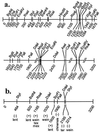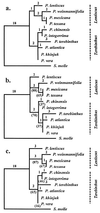Phylogeny of the genus Pistacia as determined from analysis of the chloroplast genome
- PMID: 9223300
- PMCID: PMC21542
- DOI: 10.1073/pnas.94.15.7987
Phylogeny of the genus Pistacia as determined from analysis of the chloroplast genome
Abstract
Classification within the genus Pistacia has been based on leaf morphology and geographical distribution. Molecular genetic tools (PCR amplification followed by restriction analysis of a 3.2-kb region of variable chloroplast DNA, and restriction fragment length polymorphism analysis of the Pistacia cpDNA with tobacco chloroplast DNA probes) provided a new set of variables to study the phylogenetic relationships of 10 Pistacia species. Both parsimony and cluster analyses were used to divide the genus into two major groups. P. vera was determined to be the least derived species. P. weinmannifolia, an Asian species, is most closely related to P. texana and P. mexicana, New World species. These three species share a common origin, suggesting that a common ancestor of P. texana and P. mexicana originated in Asia. P. integerrima and P. chinensis were shown to be distinct whereas the pairs of species were monophyletic within each of two tertiary groups, P. vera:P. khinjuk and P. mexicana:P. texana. An evolutionary trend from large to small nuts and leaves with few, large leaflets to many, small leaflets was supported. The genus Pistacia was shown to have a low chloroplast DNA mutation rate: 0.05-0.16 times that expected of annual plants.
Figures




References
-
- Wannan B S, Quinn C J. Bot J Linn Soc. 1991;107:349–385.
-
- Zohary M. Palestine J Bot Jerusalem Ser. 1952;5:187–228.
-
- Kokwaro J O, Gillett J B. Kew Bull. 1980;34:745–760.
-
- Grundwag M, Werker E. Israel J Bot. 1977;25:152–167.
-
- Dowling T E, Moritz C, Palmer J D. In: Molecular Systematics. Hillis D M, Moritz C, editors. Sunderland, MA: Sinauer; 1990. pp. 250–315.
Publication types
MeSH terms
Substances
LinkOut - more resources
Full Text Sources

